
Parabolic Concentrators
Collapsible Parabolas/Fresnel reflectors/Cylindro Parabolic/Plane Mirrors
Parabolic reflectors were bulky and were difficult to transport and hence collapsible concentrators were designed. A Swedish design, called Umbryoler, was probably one of the first designs to emerge on the scene (PC 1, Figure 14). It was mainly designed with campers in mind, and the unit would open out as an umbrella. The reflector was made from sheets of aluminized polyester or sheets. Fluttering focus and unstable mirror were the chief drawbacks of this otherwise good looking designs ( Annon 1981a ). Chinese ( Fang, Susan 1979 ) and Japnese designs (PC 1b) are variations of this design. In 1961, the VITA group tried out another interesting design, the famous inflatable concentrator (VITA 1961). Though it had a checkered history the design is still in vogue and, recently, it has appeared again with more firm materials in solar water pump application (Beale 1981) . Basically, the reflector is a large round aluminized polyester sheet of slightly thicker gauge, over which another clear polyester sheet was fused all along the edge. When this assembly was tightly but evenly stretched and tied between a frame and inflated, a Perfect parabolic reflector was formed (Figure 15). Fluttering focus was the main drawback.

Source:- TIDE., March 1998, 8-1, pp 1-37, For Comments, suggestions,contributions contact < ashok_kundapur@yahoo.com>
Sobako (Type PC 3, Figure 16) was an ingenious design from Germany. It was a foldable parabola with a stainless steel reflector. When opened, the reflector focused the sun’s rays at the base of a copper plate housed in a doubly glazed glass box. The area of the reflector was about 0.75 sq. m. Kanua (1979) has worked extensively on this design and finds that the glass box broke often, and difficulties were encountered while folding the reflector. He suggests many modifications but it is felt that unless the reflector area is increased the unit may not perform well. Egypt cooker is another design based on similar principles (Type PC 3b, Figure 17), Here, the reflector was a cylindrical parabolic mirror. A specially designed 5 liter box was fixed at the center for holding the cooking vessels but the German group found the unit rather bulky, and maximum temperature attainable was only 180oC. This German group evolved a similar but smaller cooker where the triangular box is hosed in the glass box.

The modified umbrella (PC 4) is, in fact, nothing but an umbrella with an aluminized polyester sheet stuck to the concave side of it. Though modified design, the reviewer still considers it as a main type for it converts an ordinary umbrella into a solar cooker. Recently, there were some reports that this design was getting popular in north India (Figure 18). As seen in Figure 18, instead of keeping the vessel on the grill fitted to the handle, the vessel could be placed on a fixed platform and the umbrella adjusted to focus the sun rays which may give a better result but cooking on a windy day could be difficult and tricky.

Source:- TIDE., March 1998, 8-1, pp 1-37, For Comments, suggestions,contributions contact < ashok_kundapur@yahoo.com>
The Russian folding cooker (Type PC 5, Figure 19) was probably the largest folding cooker ever designed. It had a reflector of 1.5 sq. m in diameter. It has been designed with lot of care to avoid flaws, as it was meant for use of Millitary personnels. The rotating screw indicated that mirror adjustment was easy and the cooking pot could be kept in an insulated receiver. It is claimed that the cooker could double as a rain shade or tent at night.

Swedish designers (cited by Venkatesam 1980) had come out with a very neat package of a solar cooker that fits into a specially designed suitcase (Figure 20). It is ideal for campers, but for day to day use the reflector has to be larger.
VITA (1961) announced another interesting design from China (Type PC 7, Figure 21). The foldable reflector, evidently a section of the parabola, made up of small mirror pieces, opens out at the base of a tripod stand holding the vessel. To some extent, the design resembles the Sobaco type described earlier.
Recently Brett White has takenup this very useful concept. He is the first contributor to this web page. He has infact used a Beach umbrella and this appears to perform better. The cooker can double as a regular umbrella. For more information visit his site. URL is provided under other links.

Brett Whites model which you can buy directly from him. Visit his site ( listed under other links )
Though the parabolic reflector was a perfect design, even good technicians, more so the villagers, found it difficult to construct one. This was how the Fresnel reflectors gained importance. The very first design in this category came from VITA in 1961 (Type F 1, Figure 22). Three to four rings of masonite (hardboard like material) were cut from a 4’ x 4’ sheet. Aluminized polyester was stuck to this. After which the rings were nailed to specially notched wooden reapers to form a Fresnel concentrator. VITA provided a template of these materials as it was a do-it-yourself project (VITA 1971). The cooking pot was supported on a rod projecting from the center. Adjustments, once in 30 minutes, were considered sufficient. Ease of construction and focusing characteristics made this design better than the regular parabolic reflector (VITA 1961). Prof. Garg, an Indian designer (Garg et al 1978), suggests further improvements by making the reflector with five to six rings.
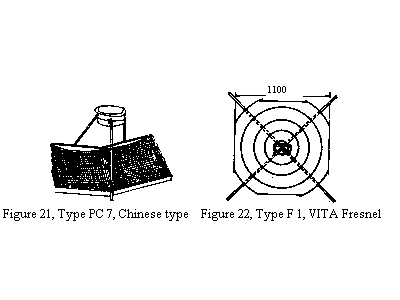
Source:- TIDE., March 1998, 8-1, pp 1-37, For Comments, suggestions,contributions contact < ashok_kundapur@yahoo.com>
In a comparative study the VITA design emerged as a top model (Garg 1978). Attracted by the simplicity of the Fresnel geometry, Steenbleek (Type F 2, Figure 23) developed an ingenious way of making Fresnel concentrator (strips of reflector materials, with the width determined by using a computer) were wound in concentric circles on a suitable support. Solar stalwarts like Edmondson (1981) claim that this design was a boon to solar designers, reflectors of any size could be easily fabricated. The author tried out this technique but encountered considerable difficulty in cutting and fixing strips.
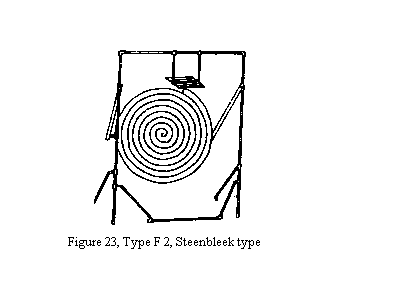
Fatangre's ( 1992 ) design is actually a Box type design wherein he incorporates a transparent Fresnel lens in the lid of the Gosh type box.
These are an interesting class of concentrators used mostly in water heating applications, but the very first design using such mirrors was that of Prata (1961) (Type CP 1, Figure 24). The cylindro-parabolic concentrator focused the rays into an insulated cylindrical box in which two or more cooking vessels could be accommodated (Fraber et al. 1975). Bowman, who built and tested the design, encountered several difficulties (Bowman, Blatt 1978), and he tried to improve upon the design. This resulted in a series of new concepts. The FIT concept No. 1, (Type CP la, Figure 25) is almost similar to Prata’s design but it has only a single cylindro-parabolic swinging reflector.
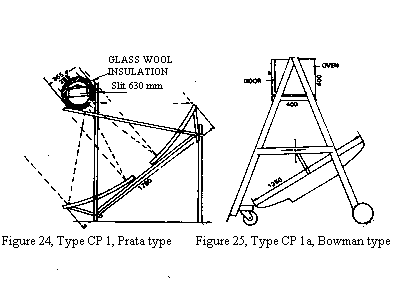
Source:- TIDE., March 1998, 8-1, pp 1-37, For Comments, suggestions,contributions contact < ashok_kundapur@yahoo.com>
Another improvement was the incorporation of a bigger and easy-to-use insulated box to house the cooking vessel. Results were slightly better. Reddy (1980) has presented a similar design.
The Edmond Scientific Supplies Company (Type CP2) was selling yet another design of this category mainly meant for warming food; it was basically a styrofoam parabola with aluminized polyester (Warenham 1995)
Plane mirrors were also in vogue in solar cooking but it was Adams who, in 1870, built a cooker at Bombay (Type MP 1, Figure 26) (Bowman, Blatt 1978). He was able to cook food for several soldiers. The cooker consisted of sixteen flat mirrors arranged to form a cone around a flat black surface meant for the cooking vessel. Further, it was covered with a glass dome with a wooden handle. Such a design was available till recently in the market. The cooker very similar to this, called ‘Solar chef’ (Type MP la) was marketed by Sedona Solar Shop, ( PO 3072, West Sedona, Arizona 86340, USA.) Prof. Bowman found the performance of the cooker satisfactory. He suggested some improvements like fixing the mirror assembly on to a stand such that it could be oriented to the sun, increasing the number and size of the assembly as well as the central dome to accommodate bigger cooking vessels. Insulating the flat plate at the bottom was also suggested some improvements like fixing the mirror assembly on to a stand such that it could be oriented to the sun, dome to accommodate bigger cooking vessels. Insulating the flat plate at the bottom was also suggested (Type MP 1b). This variation gave good results. Fraber (1975) describes a similar design where the mirror cone is comparatively larger (Figure 27).
The Chinese designers (Fang, Susan 1979) have another interesting variation (Type MP 2, Figure 28). Here, the 15-20 cm wide and 25-30 cm flat long mirror strips were arranged in a row of 14-16 pieces. Two such rows of mirrors were hinged at the centre. These mirrors focused the rays on to a cooking pan held on top of the grill projecting from the center of the hinged panels. There must have been some mechanism to tilt the mirrors, but the details were not available.
Bowman created a new design called FIT design (Type MP. 3, Figure 29) which was an offshoot of his studies on cookers especially CP la. He felt that flat-mirror assemblies were the best for villagers. The cooker consisted of a solid frame to hold an insulated box with a door to house the cooking vessels. The box did not have insulation at the bottom but a weld – mesh. Light was focused by 15 strips of mirrors held in a row at the base of this stand. Provision was made to tilt the mirrors to aid in focus and this was affected with one single lever, and the frame could also be rotated to face the sun.
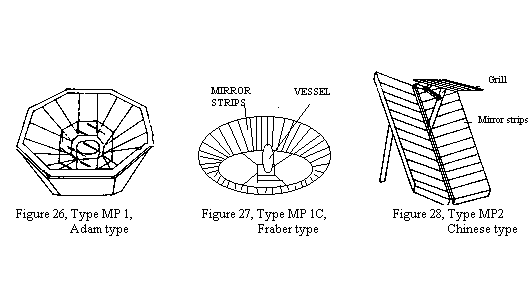
For domestic use Bowman suggests a mirror assembly of about 19 mirrors with a length of 120 cm held at an angle of 100 to the horizontal (Bowman, Blatt 1978). FIT concept 3 had a mirror assembly of 3 m and it could melt even lead (MP 327.50 C ). The FIT concepts described were excellent performers and with some more adaptations like folding the reflector for easier transportation and storing, mounting the entire assembly on bigger wheels for easy mobility, and orientation would have made these cookers very popular. Interestingly, such a cooker was fabricated here at the Manipal Institute of Technology (MIT), Manipal, under a student project, but the cooker did not perform well. The Indian Institute of Technology (IIT), New Delhi, suggests the use of such a row of mirrors (Type MP 2a) to be kept outside the house so as to concentrate the rays on to the vessel kept inside the house. Concept III proposed here by the author (Type 3c) envisages the use of two rows of mirrors as in the Chinese design and the entire assembly kept at the window. However, depending on the location and orientation of the house, it may be essential to shift the cooker from one window to another, in which case the design has to incorporate features which would enable easy mobility (Type MP 3 a, Figure 30). Concept IV proposed in this review is a variation of Bowman’s design. In this variation, the use of a larger window covered with glass is suggested at the base of the insulated cooking box (Figure 31) such that a larger reflector array could be incorporated without increasing the height of the stand, but if a 3 or 4 m long array is to be incorporated for faster cooking then the height of the stand has to be increase. In such a case, three or four steps may be added to the stand for easy access to the cooking vessels inside the insulated box. Prof. Bernard's 'NELPA' cooker appears to be slight variation from Prof. Bowmans design, but evidently an independent design of this type.
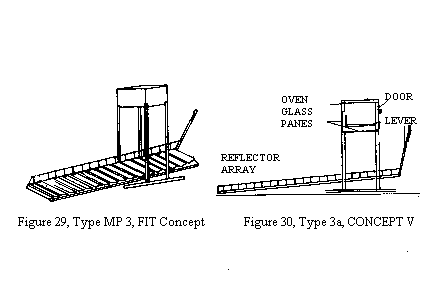
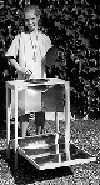
Prof. Bernard's 'NELPA' cooker, though I find the design very close to that of Prof. Bowman's FIT design presented above I feel 'NELPA' has been designed independently. For some reason Prof. Bowman's designs had not become popular.

'NELPA' when folded forms a neat little 'packet'.
Source:- TIDE., March 1998, 8-1, pp 1-37, For Comments, suggestions,contributions contact < ashok_kundapur@yahoo.com>
| PREVIOUS PART Collapsible Parabola | NEXT PARTlight from above |
For easy NAVIGATION use this chart.
OTHER LINKS are found under References S to W
click here for comments received
For Comments, suggestions,contributions contact < ashok_kundapur@yahoo.com>